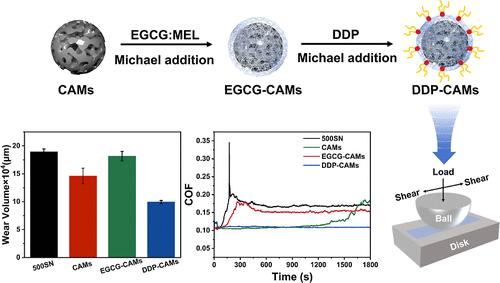Fabrication of Dialkyl Dithiophosphate-Functionalized Carbon Aerogel Microspheres for Enhanced Lubrication Performance
IF 3.9
2区 化学
Q2 CHEMISTRY, MULTIDISCIPLINARY
引用次数: 0
Abstract
Herein, functionalized carbon aerogel microspheres (CAMs) were successfully prepared by the pyrolysis of resorcinol-formaldehyde (RF) microspheres followed by surface modification. First, RF microspheres were carbonized to obtain CAMs. Afterward, the polyphenolic compound of epigallocatechin gallate (EGCG) was reacted with melamine to form a poly(EGCG) layer onto the CAM surface, followed by bonding the antiwear molecule dialkyl dithiophosphate (DDP) by the Michael addition, resulting in DDP-functionalized CAMs (DDP-CAMs). The grafting antiwear molecule DDP improved the lipophilicity of the CAMs, enabling stable dispersion in the base oil 500SN for over 10 days while also enhancing their antifriction and antiwear properties. The addition of 1.0 wt % DDP-CAMs to 500SN resulted in a 34.7% reduction in coefficient of friction and a 47.5% decrease in wear volume. The enhanced lubrication performance can be attributed to a synergistic effect. On one hand, a protective film was generated through tribo-chemical reactions. At the same time, the DDP-CAMs present at the contact interface exhibited a nanoscale rolling and self-repairing effect.

增强润滑性能的二烷基二硫代磷酸酯功能化碳气凝胶微球的制备
本文通过对间苯二酚-甲醛(RF)微球的热解和表面改性制备了功能化碳气凝胶微球(CAMs)。首先,对射频微球进行碳化制备cam。随后,表没食子儿茶素没食子酸酯(EGCG)多酚化合物与三聚氰胺反应,在CAM表面形成聚(EGCG)层,然后通过Michael加成与抗磨分子二烷基二硫代磷酸(DDP)结合,得到DDP功能化CAM (DDP-CAMs)。接枝抗磨分子DDP提高了CAMs的亲脂性,使CAMs在基础油500SN中稳定分散超过10天,同时也提高了CAMs的减摩抗磨性能。在500SN中加入1.0 wt %的DDP-CAMs,摩擦系数降低34.7%,磨损量减少47.5%。增强的润滑性能可归因于协同效应。一方面,通过摩擦化学反应生成保护膜。同时,存在于接触界面的ddp - cam表现出纳米级的滚动和自修复效应。
本文章由计算机程序翻译,如有差异,请以英文原文为准。
求助全文
约1分钟内获得全文
求助全文
来源期刊

Langmuir
化学-材料科学:综合
CiteScore
6.50
自引率
10.30%
发文量
1464
审稿时长
2.1 months
期刊介绍:
Langmuir is an interdisciplinary journal publishing articles in the following subject categories:
Colloids: surfactants and self-assembly, dispersions, emulsions, foams
Interfaces: adsorption, reactions, films, forces
Biological Interfaces: biocolloids, biomolecular and biomimetic materials
Materials: nano- and mesostructured materials, polymers, gels, liquid crystals
Electrochemistry: interfacial charge transfer, charge transport, electrocatalysis, electrokinetic phenomena, bioelectrochemistry
Devices and Applications: sensors, fluidics, patterning, catalysis, photonic crystals
However, when high-impact, original work is submitted that does not fit within the above categories, decisions to accept or decline such papers will be based on one criteria: What Would Irving Do?
Langmuir ranks #2 in citations out of 136 journals in the category of Physical Chemistry with 113,157 total citations. The journal received an Impact Factor of 4.384*.
This journal is also indexed in the categories of Materials Science (ranked #1) and Multidisciplinary Chemistry (ranked #5).
 求助内容:
求助内容: 应助结果提醒方式:
应助结果提醒方式:


